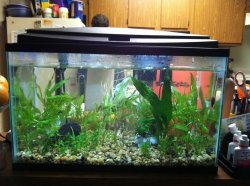It is often not possible to know if plants will handle the majority of the cycling work unless one plants fairly heavily and includes a fair amount of fast growing plants. You are correct to assume that a -lanted cycle will not proceed the same way as a purely fishless cycle without plants will. The reason is the plants take in the ammonium portion of the total ammonia. Unlike the bacteria, plants do not then make nitrite which needs to be converted to nitrate (the plants will also consume nitrate).
Eagle pretty much hit the nail on the head. You are looking for two things- no ammonia and no nitrite. The one thing he did not mention is that live plants have the very bacteria you want to develop on their roots and leaves etc. So, when you plant you seed some amount of bacteria and this includes the ones that convert the nitrite. And for this reason one should never see either the nitrite or the nitrate levels they would with a plain vanilla plantless cycle.In some cases one may never see any nitrite at all.
So we have to change what we are looking for, how often we are testing and how we react to the readings. The key remains ammonia. One should not be adding any more until what is in the tank has been processed. you need to see ammonia down at .25 ppm or less before adding more. One also must continue testing for nitrite as its absence or presence gives us an idea of how much bacteria might be at work in a tank. In tanks where the plants do most of the work, nitrite should be a rare thing and if seen it ill be low and never really climb, instead it will disappear fairly fast. In a tank where the bacteria carries more of the load, some nitrite will show up, should rise some and then drop. But the numbers will still be lower than if there were no plants.
In the end one looks for the same results no matter what the amount of plants and bacteria may be. You dose ammonia in an amount to produce 2 or 3 ppm for your volume of water, wait 24 hours and test. If ammonia and nitrite are 0, you are good to go. if they are not 0/0, then more bacteria is needed and one would continue until it is in place as shown by getting that 0/0 in 24 hours when you add ammonia again.
There are a lot of variables to cycling with plants present. Often, as suggested by eagle, one can work with a lower dose of ammonia and do fine. Plants do grow and as they grow they can handle more ammonia. Also, plants take up space in a tank. This often means one may have a lighter fish load. A lighter fish load means less ammonia creation and thus there is less to process so whatever the need for bacteria to complete the cycling chores is will be reduced.
But in the end it is all very simple, you can add fish to a planted tank as long as the number of fish going in doesn't exceed the capacity of the plants and bacteria present at the time to process the ammonia as fast as it is created. Few fish create less ammonia, the smaller fish typical in planted tanks produce less ammonia than bigger fish will. With plants a partly cycled tank is safe for some number of fish because there is no nitrite involved at that level of stocking, a partly cycled tank with no plants will not be safe since there may be some ammonia present and there will surely be nitrite.
Hope this info helped.



